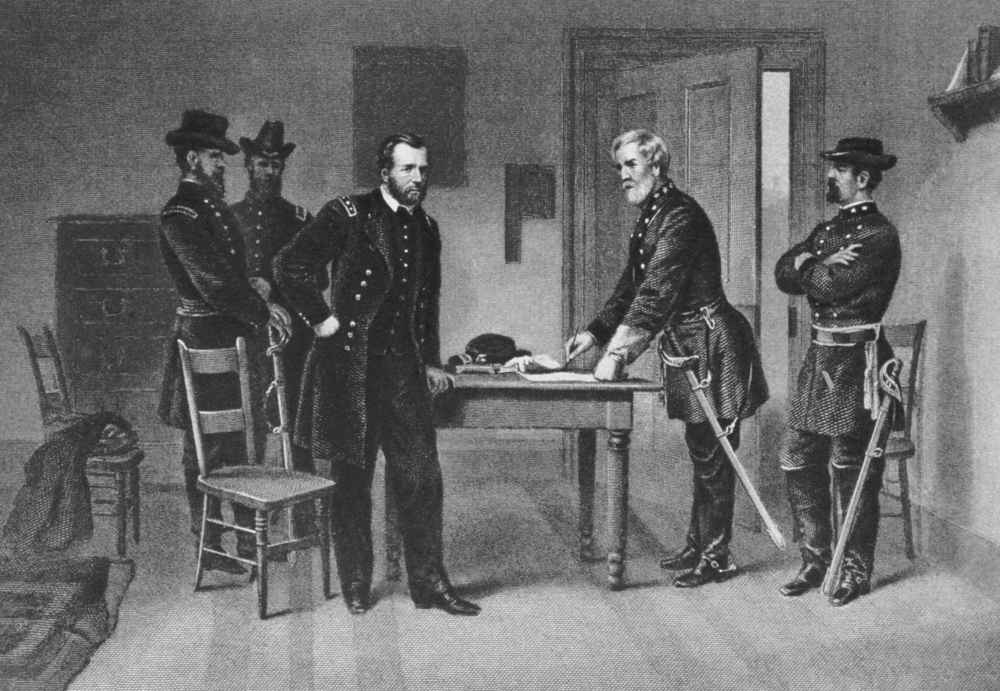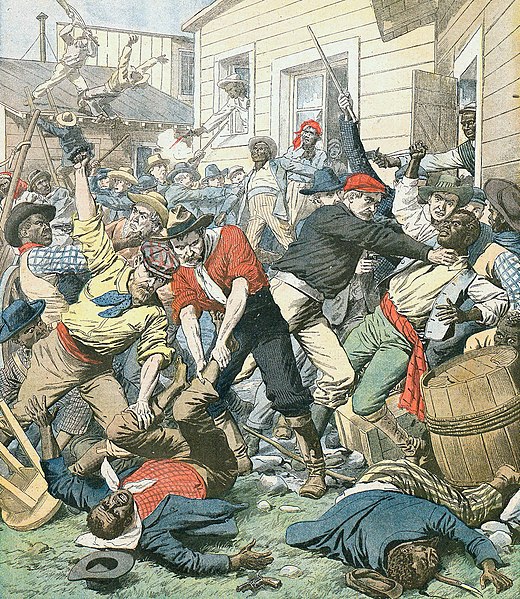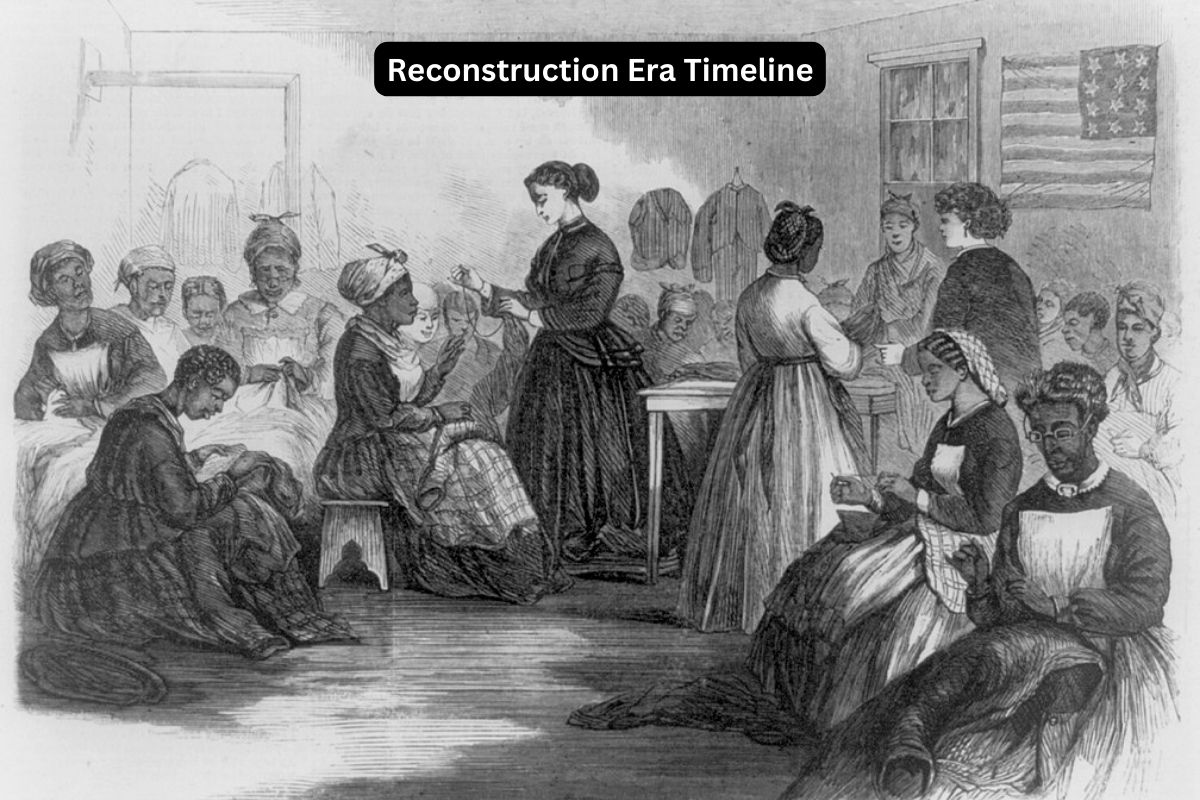The Reconstruction Era in the United States, spanning from 1865 to 1877, emerged as a pivotal period in American history immediately following the Civil War.
It was a time of profound political, social, and economic change as the nation grappled with the aftermath of the war and the complex issues of emancipation, civil rights, and the reunification of a divided country.
This era witnessed significant legislative milestones, such as the ratification of amendments that abolished slavery and granted civil rights, as well as the rise of white supremacist groups and the erosion of these rights.
In this overview, we will delve into key events and developments that characterized this tumultuous and transformative period.
| Year | Events |
|---|---|
| 1865 | April 9: General Robert E. Lee surrenders to General Ulysses S. Grant at Appomattox Court House, effectively ending the Civil War. April 14: President Abraham Lincoln is assassinated by John Wilkes Booth. December 6: The Thirteenth Amendment to the United States Constitution is ratified, abolishing slavery throughout the country. |
| 1866 | The Civil Rights Act of 1866 is passed, granting citizenship and equal rights to all people born in the United States, except for Native Americans. The Ku Klux Klan is founded in Pulaski, Tennessee, beginning a campaign of violence and intimidation against African Americans and their white allies. |
| 1867 | The Reconstruction Acts are passed by Congress, dividing the South into military districts and requiring new state constitutions that guarantee African American voting rights. The Tenure of Office Act is passed, which limits the president’s power to remove certain government officials without Senate approval. |
| 1868 | The Fourteenth Amendment to the United States Constitution is ratified, granting citizenship and equal protection under the law to all persons born or naturalized in the United States. Andrew Johnson becomes the first U.S. president to be impeached by the House of Representatives but is acquitted by the Senate and remains in office. |
| 1869-1870 | African American men are elected to public office in the South during the period known as “Black Reconstruction.” Hiram Rhodes Revels becomes the first African American to serve in the U.S. Senate. |
| 1870 | The Fifteenth Amendment to the United States Constitution is ratified, prohibiting the denial of voting rights based on race, color, or previous condition of servitude. |
| 1871 | The Ku Klux Klan Act is passed, granting the federal government the authority to suppress the activities of the KKK and other white supremacist groups. |
| 1873 | Economic depression and financial panic sweep the United States, affecting the Southern Reconstruction effort. |
| 1876 | The disputed presidential election of 1876 leads to the Compromise of 1877, which results in the removal of federal troops from the South, effectively ending Reconstruction. |
| 1877 | The era of Reconstruction officially ends, and Southern states begin implementing Jim Crow laws and racial segregation, which would persist for decades. |
Timeline of Reconstruction Era
April 9, 1865 – General Robert E. Lee Surrenders
On April 9, 1865, General Robert E. Lee, commander of the Confederate Army of Northern Virginia, surrendered to General Ulysses S. Grant, the commander of the Union Army of the Potomac, at Appomattox Court House in Virginia.
Also Read: Facts About the Reconstruction Era
This surrender marked a critical moment in the American Civil War, effectively ending the hostilities and signaling the imminent collapse of the Confederacy.

April 14, 1865 – Assassination of President Abraham Lincoln
Just days after General Lee’s surrender, on April 14, 1865, President Abraham Lincoln was assassinated by John Wilkes Booth while attending a play at Ford’s Theatre in Washington, D.C. Lincoln’s death shocked the nation, and Vice President Andrew Johnson assumed the presidency.
December 6, 1865 – Ratification of the Thirteenth Amendment
On December 6, 1865, the Thirteenth Amendment to the United States Constitution was ratified. This historic amendment abolished slavery throughout the United States, making it illegal to enslave people in any state or territory under the jurisdiction of the U.S. government.
1865 – The Civil Rights Act of 1866
In 1866, Congress passed the Civil Rights Act, which was designed to provide legal protections for the newly freed African Americans.
The Act granted citizenship and equal rights to all people born in the United States, except for Native Americans. It aimed to counteract the “Black Codes” enacted by Southern states, which sought to restrict the rights and freedoms of African Americans.
The Act was a significant step in recognizing the civil rights of African Americans, although it faced challenges and enforcement issues.
1865 – The Rise of the Ku Klux Klan
In the same year, the Ku Klux Klan (KKK) was founded in Pulaski, Tennessee. The KKK was a white supremacist organization that used violence and intimidation to target African Americans and their white allies.
Its activities included acts of terror, such as lynchings, arson, and political intimidation. The KKK’s rise signaled the beginning of a long and dark chapter of racial violence and terrorism in the South.

1867 – The Reconstruction Acts
In 1867, Congress passed a series of Reconstruction Acts that aimed to reshape the South. These acts divided the former Confederate states into military districts, each under the control of a Union military commander.
They required these states to draft new constitutions that included provisions guaranteeing African American voting rights. This marked a significant federal intervention in the affairs of the Southern states and an effort to protect the civil rights of African Americans.
1867- The Tenure of Office Act
Also in 1867, Congress passed the Tenure of Office Act, which was intended to limit the power of President Andrew Johnson. This law required Senate approval for the removal of certain government officials.
It was enacted in response to Johnson’s attempt to remove Edwin M. Stanton, the Secretary of War, from his post. The Tenure of Office Act played a role in Johnson’s impeachment proceedings.
1868 – The Fourteenth Amendment
In 1868, the Fourteenth Amendment to the United States Constitution was ratified. This amendment granted citizenship to all persons born or naturalized in the United States, including former slaves.
It also provided equal protection under the law and due process of law to all citizens. The Fourteenth Amendment was a significant legal milestone in the effort to secure civil rights for African Americans and ensure their equal treatment under the law.
1868 – Impeachment of President Andrew Johnson
In 1868, President Andrew Johnson faced impeachment by the House of Representatives. He was charged with violating the Tenure of Office Act by attempting to remove Edwin M. Stanton from his position as Secretary of War.
Johnson was impeached by the House but narrowly avoided removal from office when the Senate failed to convict him by just one vote. This episode highlighted the political tensions and conflicts between the executive and legislative branches during the Reconstruction Era.
1869-1870 – “Black Reconstruction” and African American Political Participation
During 1869 and 1870, a significant political development occurred in the Southern United States. This period is often referred to as “Black Reconstruction” because it marked a time when African American men actively participated in the political process.
Despite facing significant challenges and threats from white supremacists, African Americans registered to vote in large numbers and were elected to various positions at the local, state, and federal levels.
This was a groundbreaking moment in American history as it represented a significant step toward achieving political representation and civil rights for African Americans in the South.

1870 – Hiram Rhodes Revels
In 1870, Hiram Rhodes Revels, an African American minister and educator, made history by becoming the first African American to serve in the United States Senate.
Revels was elected as a Republican senator from Mississippi, filling the seat previously held by Jefferson Davis, the former president of the Confederacy. His election was a milestone in African American political achievement during the Reconstruction Era.
1871 – The Ku Klux Klan Act
In 1871, Congress passed the Ku Klux Klan Act, officially known as the Enforcement Act of 1871. This legislation was a response to the escalating violence and terrorism carried out by white supremacist groups like the Ku Klux Klan in the South.
The Act aimed to suppress the activities of the Klan and other similar organizations by granting the federal government the authority to take action against them. It allowed the president to use federal troops to enforce the law and protect the civil rights of citizens.
The Act marked a significant federal effort to combat the violence and intimidation used to suppress African American voting rights.
1871 – Civil Rights Act of 1871 (The Ku Klux Klan Act)
Part of the Ku Klux Klan Act, the Civil Rights Act of 1871, commonly referred to as the Ku Klux Klan Act, also provided legal protections against the actions of the Klan and other white supremacist groups.
It allowed individuals who had been victimized by these groups to seek legal remedies and federal intervention. This act was a crucial step in the federal government’s commitment to safeguarding the civil rights of African Americans in the South.
1871 – The Mississippi Plan and Voter Suppression
During this period, Southern white supremacists employed various tactics to suppress African American voting. One notable example was the “Mississippi Plan” in 1871, which aimed to intimidate African American voters through violence, threats, and fraud.
This plan served as a blueprint for similar efforts in other Southern states and contributed to the erosion of African American political gains made during the early years of Reconstruction.
1873 – Economic Depression and Financial Panic
In 1873, the United States experienced a severe economic depression and financial panic. This economic crisis, known as the Panic of 1873, was triggered by a series of events, including the failure of a major banking firm and a sharp decline in the stock market.
The panic led to widespread bank failures, business bankruptcies, and high unemployment rates. The economic hardship resulting from the panic had a significant impact on the Southern Reconstruction effort and further strained the already fragile economy of the region.
1876 – The Disputed Presidential Election of 1876
The presidential election of 1876 was one of the most contentious and disputed elections in U.S. history. It pitted Republican candidate Rutherford B. Hayes against Democrat Samuel J. Tilden.
The election results were inconclusive, with both candidates claiming victory in several states. As a result, the election was thrown into dispute, and accusations of voter fraud and political manipulation were rampant.
1877 – The Compromise of 1877
To resolve the election dispute and prevent a potential crisis, a political compromise known as the Compromise of 1877 was reached. Under this compromise, it was agreed that Republican Rutherford B. Hayes would become the president in exchange for several concessions to the Southern Democrats.
These concessions included the withdrawal of federal troops from the Southern states, effectively ending Reconstruction, and allowing Southern states to have more autonomy in governing their affairs. This compromise marked the official end of the Reconstruction Era.
1877 – The End of Reconstruction:
With the Compromise of 1877, Reconstruction came to an end. Federal troops were withdrawn from the South, and the era of federal intervention in the Southern states officially concluded.
This withdrawal of federal oversight left African Americans vulnerable to the imposition of discriminatory laws, such as the Jim Crow laws, which enforced racial segregation and disenfranchised African American voters.
It marked the beginning of a long period of racial segregation, discrimination, and violence against African Americans in the South.
1877 – The Rise of Jim Crow Laws
Following the end of Reconstruction, Southern states implemented a series of laws known as “Jim Crow” laws. These laws enforced racial segregation in public facilities, schools, transportation, and various aspects of daily life.
Jim Crow laws effectively codified racial discrimination and segregation, perpetuating racial inequality and denying African Americans their civil rights for decades to come.
1877 – Erosion of Civil Rights
The end of Reconstruction and the rise of Jim Crow laws led to the erosion of civil rights for African Americans in the South. African Americans faced voter suppression, violence, and limited economic opportunities.
The promise of equality and civil rights that had briefly flourished during the early years of Reconstruction was replaced by a system of racial segregation and discrimination.
